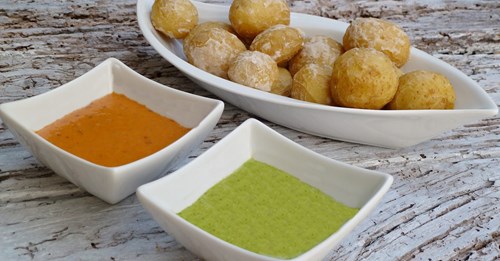One of the star products of gastronomic gastronomy that usually draws the attention to our visitors, is undoubtedly the mojo.
The mojo, is a typical canarian sauce, based on pepper (green or red), oil, garlic and vinegar, which is then added, depending on the type of mojo you want to make, parsley, cilantro , Saffron, pepper, peppers, cumin, paprika, and a myriad of herbs, nuts, spices, tomatoes and even avocado.
The origin of the word mojo, is believed to come from the Portuguese “sauce” which translated into Castilian means sauce. Its appearance in the Canary Islands was due to the incipient commerce that developed in different parts of the planet and to the arrival of the spices that crossed the maritime routes intercontinental. The strategic geographical situation of our islands, made them the ideal place to leave and collect all kinds of goods. The islands, became a bridge between America, Europe and Africa and this fact, is a key element for the appearance of mojo, as we know it today.
The mojo has become, over the years, as a sign of the gastronomy of the Canary Islands from the gastronomic point of view, it is used to reinforce and enhance the flavor of the dishes or products of the island.

Popularly classified in red, green, soft or spicy mojos, but there are more than twenty mojos, which according to experts can be grouped in traditional mojos, salmorejos, pickles and other sauces.
The best known are red mojo picón and mojo verde. Green mojos often accompany stewed fish, fried or seafood like barnacles. The red ones accompany the strongest and intensely flavored dishes such as pork meat, jareas, sardines, rabbit or roasted. And as it could be lacking, the famous wrinkled potatoes, canary dish par excellence, are always accompanied by a good mojo.
There is no single recipe, everything will depend on the island, municipality and even the home where it is prepared. In the same way, we can also say that there are not usually two mojos alike, because each one has a peculiar elaboration since everything depends on the ingredients, the quantities and the hand that has for its elaboration.
Usually, in canarian homes, the mojo is prepared with the traditional mortar or mortar, slower but more authentic. Raw ingredients are used, allowing them to conserve all their vitamins.
Take advantage of your stay in La Gomera and taste some wrinkled potatoes with a good mojo and if you also want to make the famous red mojo picón in your house, we will make the recipe easier. Bon Appetite!
Red spicy “mojo” recipe for a cup of approximately 250 grams
Ingredients:
-2 palm peppers (fresh or dried).
-2 picona peppers (fresh or dried).
-1 pepper (to thicken).
-1 teaspoon ground sweet paprika.
-2 teaspoons ground cumin.
-4 cloves garlic.
-1 cup (coffee) olive oil.
-1/2 cup of wine vinegar.
-1 teaspoon coarse salt.
Preparation:
1) If the peppers to be used are dry, boil for 5-10 minutes or soak in water 4-10 hours.
2) Peel garlic and cut into small pieces
3) Cut the pepper into pieces and remove the seeds.
4) Put all the ingredients (except the oil and the vinegar) in the mortar and chop everything well.
5) When you have the mashed, add the oil little by little and continue to crush in the mortar and finally add the vinegar.
Trick to soften and last longer: boil for 2-3 minutes.
